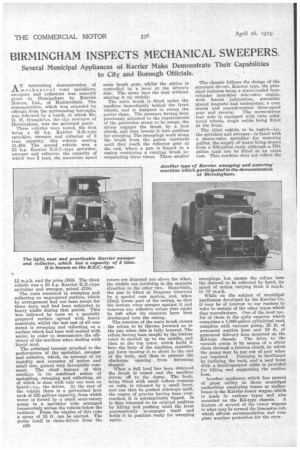BIRMINGHAM INSPECTS MECHANICAL SWEEPERS.
Page 12

If you've noticed an error in this article please click here to report it so we can fix it.
Several Municipal Appliances of Karrier Make Demonstrate Their Capabilities to City and Borough Officials:
AN interesting demonstration of mechanical road sprinklers, sweepers and collectors was recently given in Birmingham by Harrier Motors, Ltd., of Huddersfield. The demonstration, which was attended by officials from the surrounding boroughs, was followed by a lunch, at which Mr. EL H. Humphries, the city surveyor of Birmingham, was the principal guest.
Three vehicles were tested, the first being a 45 h.p. Harrier 1t..-type sprinkler, sweeper and collector of 5 tons capacity, this vehicle costing 11,450. The second vehicle was a 25 h.p. Harrier R.S.C.-type sprinkler, sweeper and collector, the capacity of which was 2 tons, the maximum speed 15 m.p.h. and the price £950. The third vehicle was a 25 h.p. Harrier R.B.-type sprinkler and sweeper, priced 1750.
The tests consisted in sweeping and collecting an unprepared surface, which by arrangement had not been swept for three days, and had been subjected to heavy traffic during that period. This was followed by tests on a specially prepared surface spread with heavy materials, whilst the last test of all consisted in sweeping and collecting on a surface which had been well soaked with water, in order to demonstrate the efficiency of the machine when dealing with liquid mud.
The principal interest attached to the performance of the sprinkler, sweeper and collector, which, on account of its rapidity and economy of action and small size, gained very favourable comment. The chief feature of this machine is its combined action of sprinkling, sweeping and collecting, all of which is done with only one man on board--i.e., the driver. At the rear of the vehicle there is a galvanized iron tank of 150 gallons capacity, from which water is forced by a small semi-rotary pump to a sprinkler tube arranged transversely across the vehicle below the radiator. From the nipples of this tube a spray of 15 ft. can be ejected. The pump itself is chain-driven from the
C28 main brush gear, whilst the action is controlled by a lever at the driver's side. The spray lays the dust without stirring it up unduly.
The main brush is fitted under the machine immediately behind the front wheels, and is designed to sweep the gutter clean. The pressure having been previously adjusted to the requirements of the particular street to be swept, the driver engages the brush by a foot clutch, and then lowers it into position for sweeping. The sweepings work along the brush from the: gutter outwards until they reach the collector gear at the end where a pan is hinged to a casing containing a rotating brush incorporating three vanes. Three smaller rotors are disposed one above the other, the middle one revolving in the opposite direction to the other two. Meanwhile, the pan is lifted at frequent intervals by a special cam motion, and, when lifted, forms part of the casing, so that the bottom rotor scrapes against it and removes any adhesive refuse that might be left after its contents have been discharged into the casing.
The rotation of the main brush causes the refuse to be thrown forward On to the pan when this is fully lowered. The refuse having been caught by the bottom rotor is carried up to the middle, and then to the top rotor, which hurls it tnto the body of the machine, centrifugal force causing it to shoot to the end of the body, and thus to prevent the discharge opening from becoming clogged.
When a full load has been obtained the brush is raised and the machine driven off to the dump. The body, being fitted with small rollers running on rails, is released by a small lever, and can then be pushed sideways until, the centre of gravity having been overreached, it is automatically tipped. It is then returned to its original position by lifting and pushing until the lever automatically re-engages itself and holds it in position ready for sweeping again. The chassis follows the design of the standard 30-cwt. Harrier type, the principal features being a water-cooled four cylinder monobloc side-valve engine, with forced lubrication, accessibly placed magneto and carburetter, a cone clutch and centrol-control three-speed gear and reverse. The worm-driven rear axle is equipped with twin solidtyred wheels, single solids being fitted at the front.
The third vehicle to be tested—i.e., the sprinkler and sweeper—is fitted with a sleeve-valve sprinkler for watering gullies, the supply of water being drawn from a 300-gallon tank, although a 750gallon tank can be fitted at an extra cost. This machine does not collect the sweepings, but passes the refuse into the channel to be collected by hand, its speed of action varying from 3 m.p.h. to 15 m.p.h.
While on the subject of Municipal appliances developed by the Harrier Co. it may be of interest to our readers to refer to certain of the other types which they manufacture. One of the most useful of these is the gully emptier, which comprises a 1,000-gallon cylindrical tank complete with vacuum pump, 25 ft. of armoured suction hose and 10 ft. of armoured delivery hose mounted on the K4-type chassis. The drive to the vacuum pump is by means of a silent chain through a friction clutch, by which the pump may be put out of gear when
not required. Draining is facilitated by inclining the tank, and a neat hoist with a hand-operated cable is provided for lifting and supporting the suction hose.
Another appliance which has proved of great utility to those municipal authorities employing trams or trolleybuses is the Harrier tower wagon, which is made in various types and also mounted on the K4-type chassis. A feature of several of the tower wagons is what may he termed the limousine cab, which affords accommodation and complete weather protection for the crew.
































